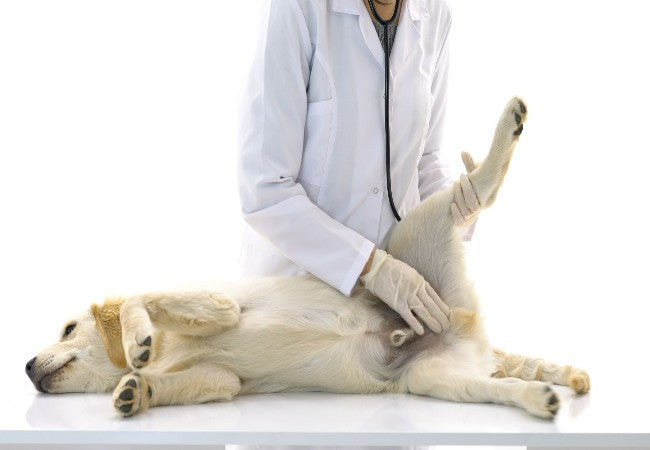Vet’s 2025 Guide to Canine Paraphimosis Urgent Care for “Stuck Penis”🩺

In this article
Vet’s 2025 Guide to Canine Paraphimosis Urgent Care for “Stuck Penis”🩺
By Dr. Duncan Houston BVSc
💡 Introduction
Canine paraphimosis—when a dog’s penis becomes stuck outside the preputial sheath—is a painful emergency that requires swift action. In 2025, we will have clear protocols for initial home steps, emergency clinic treatments, and long-term prevention. This guide provides detailed veterinary advice, nursing care tips, and how Ask A Vet can support you every step of the way. 🐶❤️
1. What Is Paraphimosis?
Paraphimosis occurs when the penis cannot retract back into the prepuce. This leads to swelling, dryness, compromised circulation, and severe pain, creating the potential for tissue damage and necrosis within hours if untreated.
2. Why Does It Happen?
Common triggers include:
- Hair rings, dirt, or debris around the sheath are causing constriction.
- Congenital small preputial opening—unable to accommodate retraction.
- Mating or excitement leading to erection and swelling.
- Trauma, neurological issues, or tumors impeding retraction.
3. Recognizing the Signs
Look out for:
- A penis visible for >20–30 minutes.
- Swelling, redness or discoloration.
- Excessive licking or distress.
- Urination difficulty, discharge, or visible edema.
These signs signal urgency—without prompt care, tissue death or urethral damage may occur.
4. Immediate Actions at Home
If you catch it early:
- Gently cleanse with warm water or mild soap.
- Use sterile lubricant (like K-Y) to moisten the penis.
- Cool compresses or sugar paste to reduce swelling and aid retraction.
- Gently push the sheath forward to invert it and allow retraction.
These measures may reverse paraphimosis—but veterinary evaluation is still essential to confirm no damage and prevent recurrence.
5. Veterinary Emergency Treatment
5.1 Physical Reduction
Vet performs cleaning, lubrication, and manual reduction—often under sedation.
If swelling persists, they may use cold packs, sugar, or acepromazine to ease reduction.
5.2 Temporary Fixes
- Purse-string sutures to hold the penis in place until swelling subsides.
- Catheterization if urethral damage or difficulty urinating is present.
5.3 Surgical Corrections
- Preputial ostial enlargement to prevent recurrence.
- Preputial advancement or phallopexy for chronic or congenital cases.
- Debridement or partial penile amputation in severe tissue necrosis.
6. Aftercare & Long-Term Management
- Prevent licking with ointment and cone use until healed.
- Complete any prescribed antibiotics or anti-inflammatories.
- Clean the sheath after breeding or excitement to remove debris/hair.
- Trim guard hairs around prepuce regularly.
7. Prevention Strategies
- Groom and clean genital area, especially in long-haired breeds.
- Monitor after breeding or mating, with prompt hygiene afterwards.
- Inspect the sheath during routine grooming—remove any debris, hair, or foreign objects.
- Consider preventive surgery if anatomically predisposed.
8. Prognosis & Outlook
- Early correction: typically full recovery with no lasting damage.
- Delayed treatment: higher risk of necrosis, urinary issues, permanent damage.
- Surgical cases: outcomes are excellent with proper technique and post-op care.
9. Ask A Vet—Your Support System
Our app helps you:
- Track healing progress and flag concerns early.
- Receive medication and cleaning reminders.
- Chat 24/7 about post-care questions or signs of recurrence.
- Get guidance on grooming and behavioral changes to prevent relapse.
🔍 Key Takeaways
- Paraphimosis is a painful veterinary emergency.
- Early home steps can help—but vet evaluation is essential.
- Veterinary treatment ranges from manual reduction to surgery.
- Post-care, grooming, and monitoring are crucial to prevent recurrence.
- With prompt care, most dogs return to full health and urinary function.
Conclusion ❤️
Paraphimosis in dogs may be an uncomfortable topic—but understanding the condition and acting quickly saves tissue, prevents serious complications, and ensures a smooth recovery. With 2025’s veterinary expertise and tools like Ask A Vet, you’re not alone—your dog can thrive again with proper care and attention. 🐾
Dr Duncan Houston BVSc – dedicated to clear, compassionate veterinary guidance.
Discover more at AskAVet.com and download the Ask A Vet app for expert help through every stage of care. ❤️






